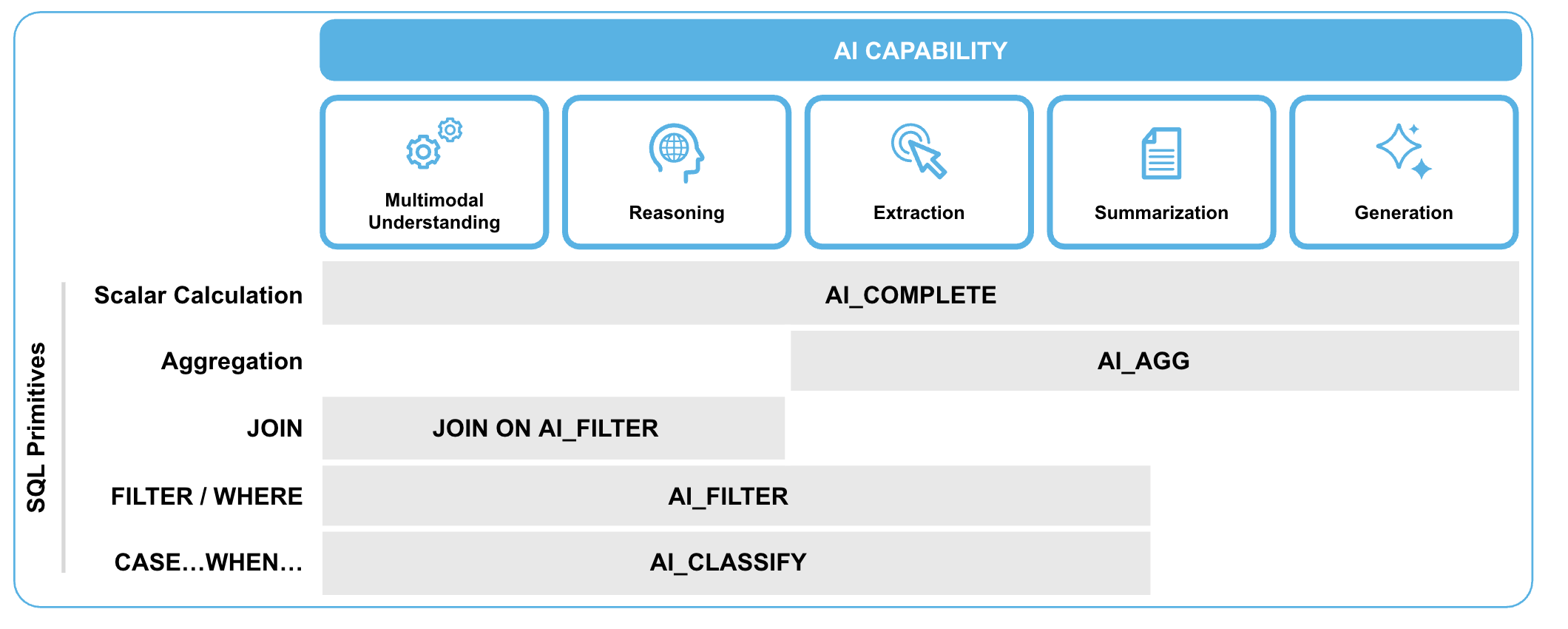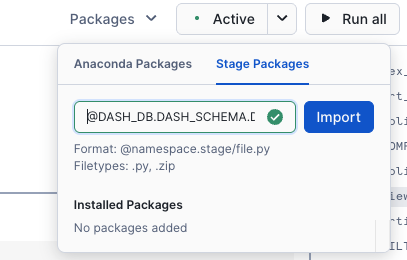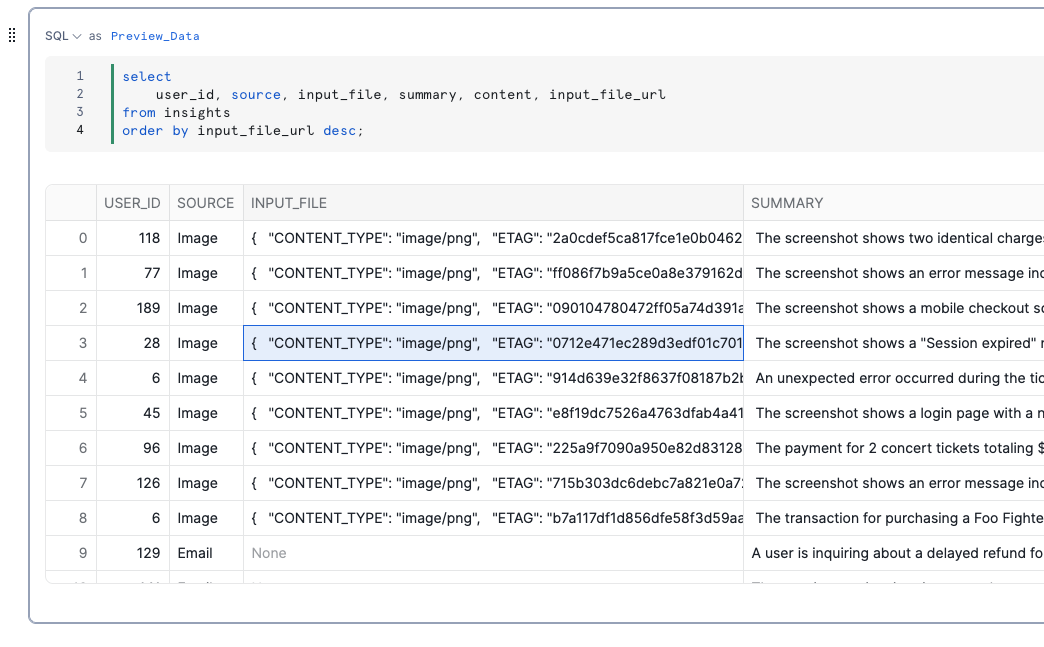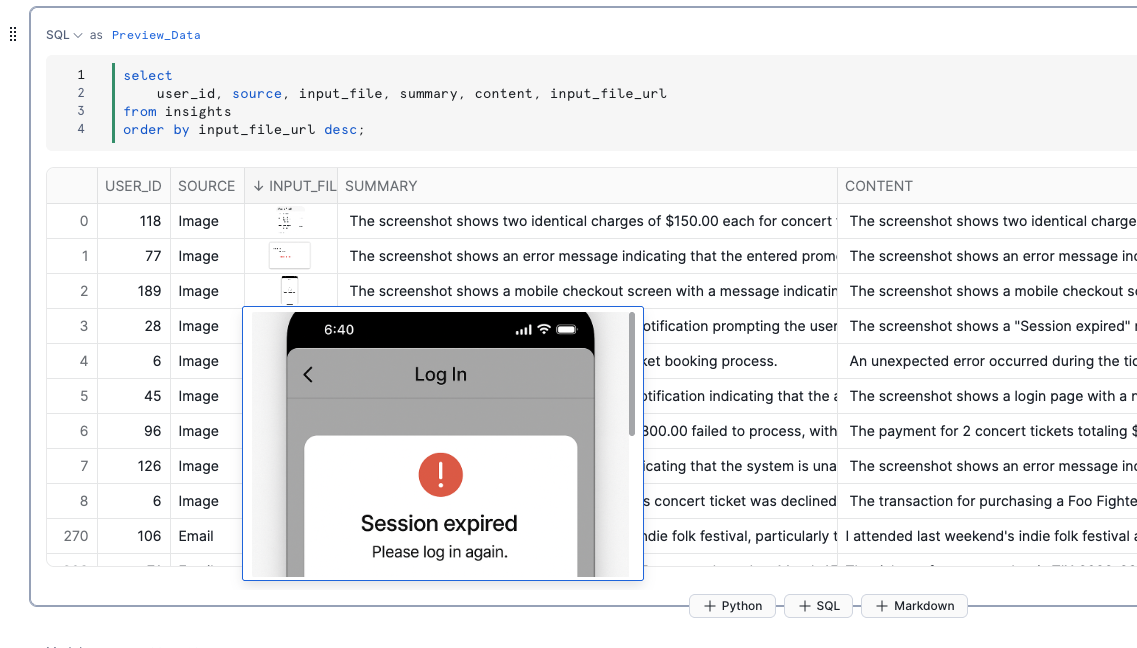Cortex AISQL reimagines SQL into an AI query language for multimodal data, bringing powerful AI capabilities directly into Snowflake's SQL engine. It enables users to build scalable AI pipelines across text, images, and audio using familiar SQL commands. With native support for multimodal data through a new FILE datatype, Cortex AISQL seamlessly integrates AI operators with traditional SQL primitives like AI_FILTER and AGGREGATE, allowing analysts to process diverse data types more efficiently and cost-effectively while maintaining enterprise-grade security and governance.
What is Cortex AISQL?
Cortex AISQL bridges the traditional divide between structured and unstructured data analysis, eliminating the need for separate tools and specialized skills.
It delivers three key benefits:
- Simplicity through familiar SQL syntax that transforms any analyst into an AI engineer without complex coding
- High-performance processing through deep integration with Snowflake's query engine, offering 30%+ faster query runtime
- Cost efficiency with up to 60% savings compared to traditional AI implementations
By unifying all data types in a single platform with zero setup required, Cortex AISQL democratizes AI-powered analytics across the enterprise.

Use Cases
Cortex AISQL benefits organizations across industries dealing with diverse data types including:
- Financial services: Automate corporate action processing by filtering news feeds and joining with internal holdings
- Retail and e-commerce: Detect product quality issues by analyzing customer reviews and identifying concerning patterns
- Healthcare: Accelerate medical research by bridging unstructured clinical notes, transcripts and images with structured patient records
- Legal: Streamline contract analysis and compliance monitoring
- Media: Optimize content and target advertising through multimodal data analysis
Business analysts can extract insights without AI expertise, data engineers can build simpler pipelines, and data scientists can create richer feature sets, all using familiar SQL.
Prerequisites
- Access to a Snowflake account in one of these regions with ACCOUNTADMIN role. If you do not have access to an account, create a free Snowflake trial account.
NOTE: Individual functions in the Cortex AISQL suite are Preview Features. Check the status of each function on its SQL reference page before using it in production. Functions not marked as preview features are generally available (GA) and can be used in production.
What You Will Learn
You'll learn how to use powerful operators of Cortex AISQL to analyze multimodal data within Snowflake using natural language.
- AI_COMPLETE: Generate AI-powered text completions or descriptions for various inputs including text and images
- AI_TRANSCRIBE: Transcribe audio files
- AI_FILTER: Semantic filtering
- AI_AGG: Aggregate insights across multiple rows
- AI_CLASSIFY: Text and image classification
What You Will Build
Snowflake Notebook that helps you get started with using Cortex AISQL with multimodal data across test, images, and audio files.
Step 1. In Snowsight, create a SQL Worksheet and open setup.sql to execute all statements in order from top to bottom.
Step 2. Download sample images files and use Snowsight » Data » Add Data » Load files into a Stage to upload them to DASH_DB.DASH_SCHEMA.DASH_IMAGE_FILES stage created in step 1.
Step 3. Download sample audio files and use Snowsight » Data » Add Data » Load files into a Stage to upload them to DASH_DB.DASH_SCHEMA.DASH_AUDIO_FILES stage created in step 1.
Step 4. In Snowsight, create a SQL Worksheet and open images.sql to execute all statements in order from top to bottom to create IMAGES table.
Step 5. In Snowsight, create a SQL Worksheet and open audio.sql to execute all statements in order from top to bottom to create VOICEMAILS table.
Step 6. Click on cortex_aisql.ipynb to download the Notebook from GitHub. (NOTE: Do NOT right-click to download.)
Step 7. In Snowsight:
- On the left hand navigation menu, click on Projects » Notebooks
- On the top right, click on Notebook down arrow and select Import .ipynb file from the dropdown menu
- Select cortex_aisql.ipynb file you downloaded in the step above
- In the Create Notebook popup
- For Notebook location, select
DASH_DBandDASH_SCHEMA - For Python environment, select
Run on warehouse - For Query warehouse, select
DASH_WH_S - For Notebook warehouse, select default
SYSTEM$STREAMLIT_NOTEBOOK_WH - Click on Create button
- For Notebook location, select
Step 8. Open Notebook
- Click on Start button on top right
Here's the code walkthrough of the cortex_aisql.ipynb notebook that you downloaded and imported into your Snowflake account. NOTE: Individual functions in the Cortex AISQL suite are Preview Features. Check the status of each function on its SQL reference page before using it in production. Functions not marked as preview features are generally available (GA) and can be used in production.
Once the status changes from Starting to Active, run through all the cells from top to bottom.
Cell Import_Libraries
Import libraries required for running cells in the notebook.
Cell Multimodal
Identify customer issues across text, image, and audio data using AI_COMPLETE() and AI_TRANSCRIBE() to see how the SQL operators work seamlessly across all modalities.
- Text: Emails
- Images: Screenshots
- Audio: Voicemails
Cell Preview_Data
Notice that native FILE datatype allows for consolidating all data formats into one table.
Cell AI_FILTER
Semantically "JOIN" customer issues with existing solutions using JOIN ... ON AI_FILTER().
Cell AI_AGG
Get aggregated insights across multiple rows using AI_AGG().
Cell AI_CLASSIFY
Classification of labels that can be used in downstream applications using AI_CLASSIFY(). For example, to train ML models.
==================================================================================================
OPTIONAL: Display images in cell results
If you'd like to see images displayed in the Notebook as part of the consolidated data in Preview_Data cell, follow these instructions.
Step 1. In a SQL worksheet, execute the following statement to create a Snowflake managed internal stage to store the sample python files.
create or replace stage DASH_DB.DASH_SCHEMA.DASH_PY_FILES
encryption = (TYPE = 'SNOWFLAKE_SSE')
directory = ( ENABLE = true );
Step 2. Use Snowsight to upload snowbooks_extras.py on stage DASH_DB.DASH_SCHEMA.DASH_PY_FILES.
Step 3. Reopen existing cortex_aisql.ipynb Notebook, and on the top right click on Packages » State Packages and enter @DASH_DB.DASH_SCHEMA.DASH_PY_FILES/snowbooks_extras.py and then click on Import.

Step 4. If the session is Active, click on it to end the current session. Otherwise, click on Start to start a new session which will also update the packages list and include our custom package snowbooks_extras.
Step 5. Add import snowbooks_extras to the libraries list under Import_Libraries and run the cell.
Step 6. Now if you run Preview_Data cell, you will see images displayed in INPUT_FILE column as shown below.


Congratulations! You've successfully created a Snowflake Notebook that helps you get started with using Cortex AISQL with multimodal data.
What You Learned
You've learned how to use powerful operators of Cortex AISQL to analyze multimodal data within Snowflake using natural language.
- AI_COMPLETE: Generate AI-powered text completions or descriptions for various inputs including text and images
- AI_FILTER: Semantic filtering
- AI_TRANSCRIBE: Transcribe audio files
- AI_AGG: Aggregate insights across multiple rows
- AI_CLASSIFY: Text and image classification